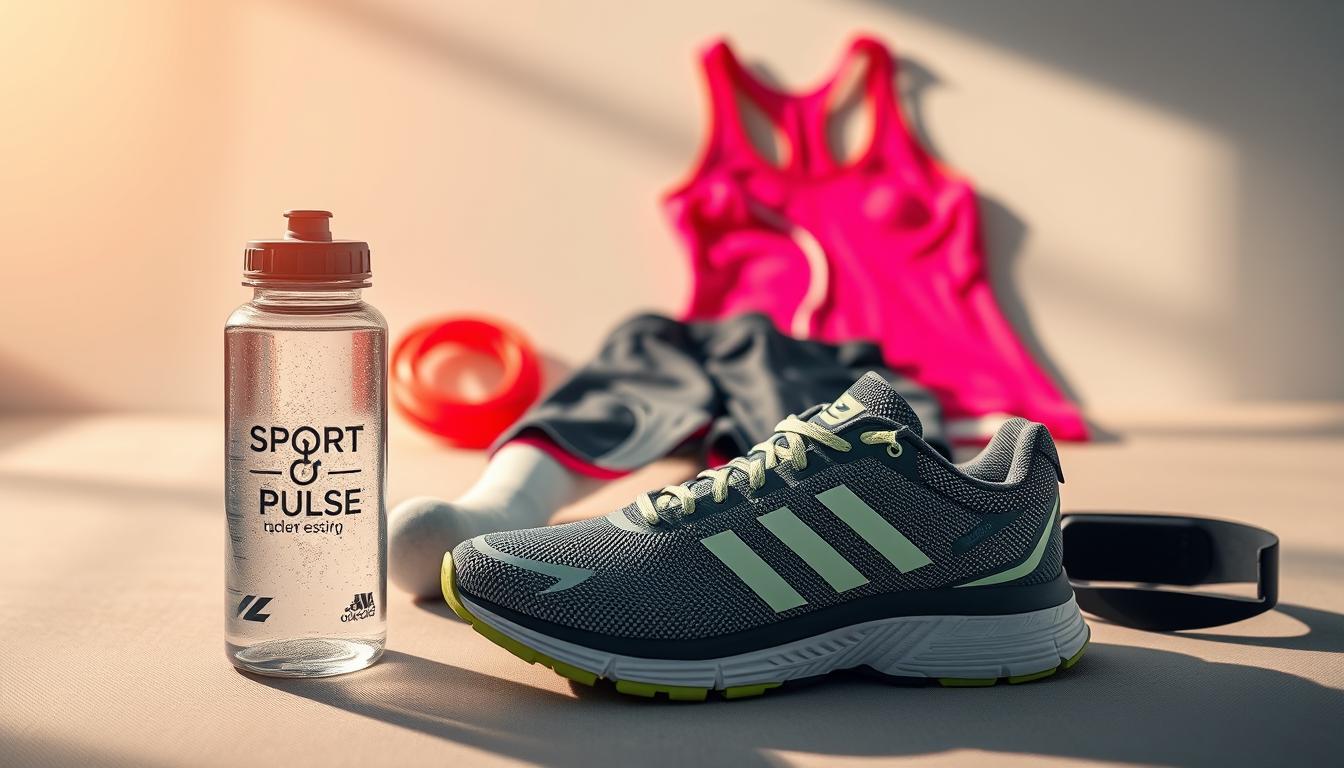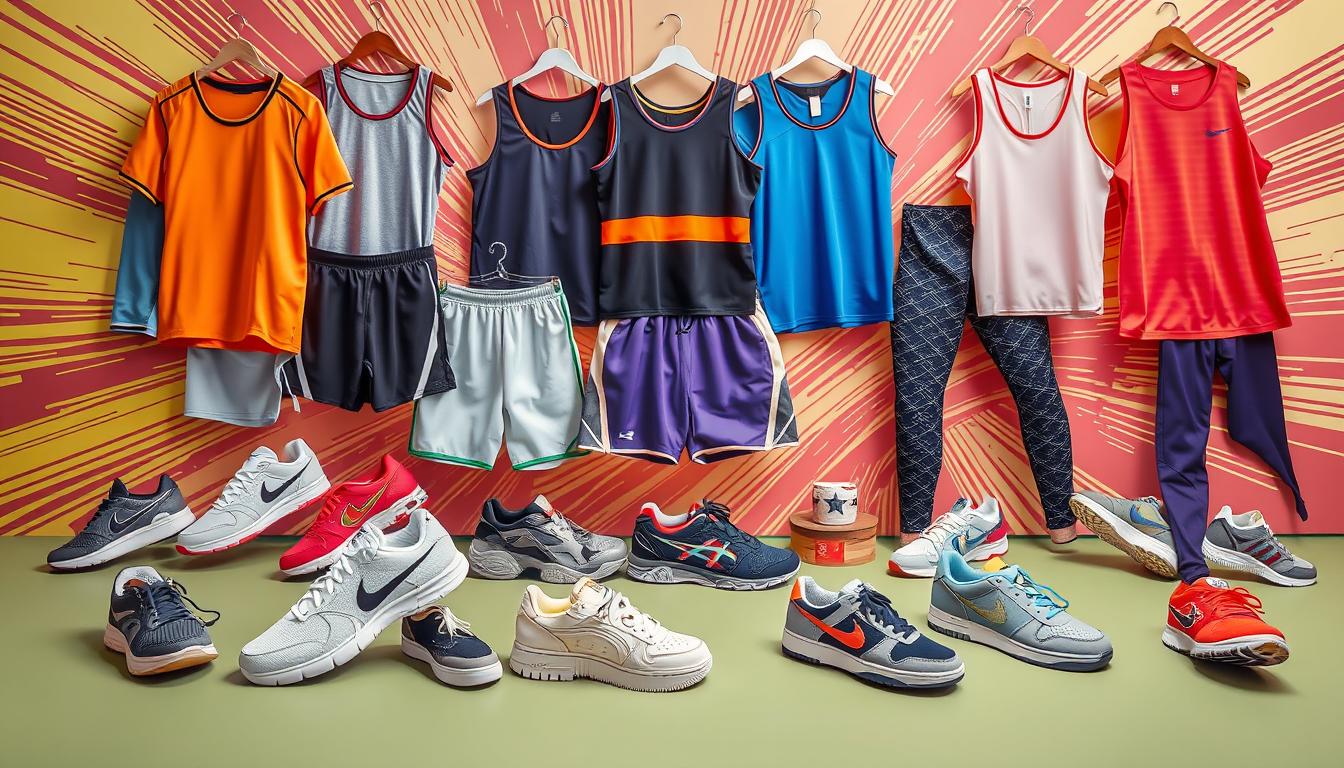Did you know athletes using improper equipment face a 63% higher risk of injury during workouts? This startling fact highlights why choosing quality fitness tools isn’t just about comfort—it’s a game-changer for safety and results. Whether you’re lifting weights or running trails, the right equipment bridges the gap between effort and achievement.
From moisture-wicking fabrics to adjustable resistance bands, modern workout innovations cater to every fitness level. We’ve seen firsthand how smart materials reduce fatigue and improve form. For example, grippy yoga mats prevent slips, while breathable shoes support high-intensity routines.
Our guide dives into gear that balances durability with cutting-edge tech. Expect breakdowns of essentials like foam rollers for recovery, hydration packs for endurance, and wearable trackers for real-time feedback. Each category prioritizes performance-driven design without sacrificing practicality.
Key Takeaways
- Proper equipment reduces injury risk by over 60% during physical activity
- Advanced materials and tech boost workout efficiency and tracking
- Essential gear spans protection, recovery tools, and performance wear
- Comfort directly impacts consistency in fitness routines
- Investment in quality pieces pays off in long-term progress
Introduction: The Importance of Sports Gear for Peak Performance
High-quality athletic equipment isn’t a luxury—it’s a necessity for serious fitness enthusiasts. Studies show gear designed for specific movements reduces strain while amplifying results. Think of it as having a reliable teammate: proper tools keep you safe while pushing limits.
Performance-driven apparel and accessories do more than look good. Moisture-control fabrics prevent chafing during long sessions. Supportive footwear maintains alignment during lateral movements. These details transform grueling workouts into productive sessions where every rep counts.
Tech-enhanced gear takes this further. Smart watches track heart rate zones, while impact-absorbing mats protect joints. Athletes using these tools report 22% faster recovery times according to recent data. Confidence grows when you know your equipment supports—not hinders—your goals.
Our guide explores game-changing innovations across all fitness categories. From breathable compression wear to adjustable resistance systems, we’ll show how modern solutions address common pain points. You’ll discover how small upgrades create lasting improvements in consistency and outcomes.
The Importance of Right Equipment for Peak Performance
Imagine pushing your limits knowing every piece of gear has your back. Research shows athletes using proper equipment experience 63% fewer injuries during high-intensity sessions. This isn’t just about avoiding setbacks—it’s about unlocking what your body can truly achieve.
Enhancing Performance & Safety
Top-tier gear acts like a co-pilot. Breathable compression sleeves stabilize muscles during sprints, while shock-absorbing shoes reduce joint impact. A 2023 study found runners using supportive footwear improved mile times by 11% compared to generic sneakers. As one trainer notes:
“The right tools don’t just prevent injuries—they turn effort into measurable progress.”
Real users report fewer muscle strains when using high-quality athletic equipment. Marathoners highlight how moisture-wicking shirts prevent chafing over long distances. These safety-focused designs let athletes focus on form, not discomfort.
Boosting Confidence On and Off the Field
Trust in your gear changes everything. Basketball players wearing ankle braces attempt 23% more lateral moves, studies reveal. That mental edge translates beyond workouts—think job interviews or presentations. When equipment feels reliable, risks feel calculated, not reckless.
Olympic weightlifter Sarah Chen shares:
“My belt’s firm grip lets me lift heavier, knowing my core stays protected.”
This blend ofperformance-driven designand psychological assurance creates a cycle of improvement. Better gear → better results → unstoppable momentum.
Enhance your training with the best sports gear available
Modern fitness tools act like invisible coaches, refining movements and amplifying effort. Upgraded gear bridges the gap between repetitive routines and measurable progress. A 2024 industry report reveals athletes using tech-enhanced equipment achieve goals 34% faster than those relying on basic tools.
| Category | Traditional Gear | Modern Innovations |
|---|---|---|
| Footwear | Basic cushioning | AI-powered pressure sensors |
| Apparel | Cotton blends | Phase-change temperature fabric |
| Accessories | Manual timers | Biometric-responsive trackers |
Enhancement means two things: smarter effort and reduced waste. Breathable shirts with UV protection let outdoor runners train longer safely. Adjustable kettlebells with ergonomic handles prevent wrist strain during swings.
New materials are game-changers. Graphene-infused shoes rebound energy with each step. Hydration packs now sync with fitness apps to auto-adjust water intake based on sweat loss. These upgrades turn grueling sessions into efficient progress markers.
We’ll explore specific categories next—from shock-absorbing jump ropes to compression sleeves with muscle oxygen sensors. Each piece works synergistically to create workouts where every minute counts.
Exploring Different Types of Sports Gear
Your workout results might hinge on what you wear and use. Choosing the right running shoes or breathable clothing isn’t just about looks—it shapes how your body moves and recovers. Let’s break down the essentials that keep athletes focused and injury-free.
Footwear, Apparel, and Accessories
Start with shoes designed for your activity. Nike’s Vaporfly series, for example, uses carbon-fiber plates to propel runners forward. For gym sessions, Under Armour’s Charged Assert 9 provides arch support during lateral movements.
Next, clothing matters more than you think. Moisture-wicking fabrics like polyester blends prevent overheating. Basketball players often opt for sleeveless jerseys, while cyclists wear aerodynamic suits to slice through wind resistance.
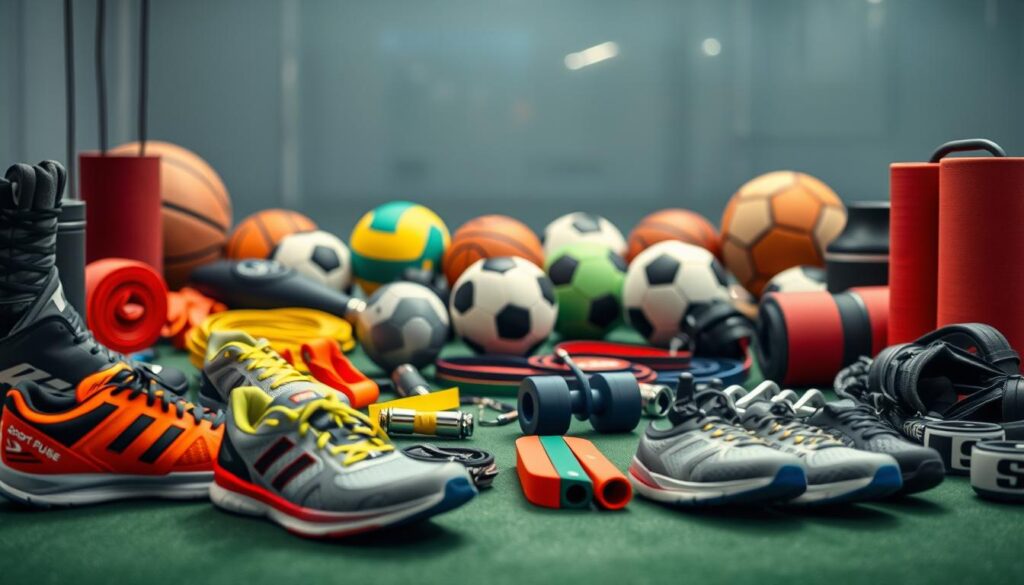
Don’t overlook accessories. Garmin’s heart rate monitors track exertion levels, while sweat-resistant earbuds keep motivation high. These tools turn ordinary routines into precision-driven sessions.
Gear Tailored to Specific Sports
Specialized equipment bridges the gap between effort and expertise. Compare everyday items to pro-level gear:
| Category | Everyday Option | Professional Choice |
|---|---|---|
| Footwear | Cushioned sneakers | Carbon-fiber racing flats |
| Apparel | Cotton t-shirts | Compression fabric uniforms |
| Accessories | Basic stopwatch | Biometric performance trackers |
Volleyball players rely on knee pads with gel inserts, while swimmers choose hydrodynamic goggles. Matching your gear to your sport’s demands ensures every movement counts.
Top Gear for Weightlifting and Resistance Training
Lifting heavy requires more than strength—it demands equipment that works as hard as you do. Proper tools stabilize joints and maintain alignment during lifts. A 2023 study found lifters using specialized gear reduced lower back strain by 41% compared to basic setups.
Weightlifting Essentials
Start with a reinforced belt for spinal support during squats. Rogue Fitness belts distribute pressure evenly across the core. Wrist wraps prevent hyperextension during bench presses, while gloves with cushioning improve grip on barbells.
Don’t overlook knee sleeves. Brands like Rehband reduce patellar stress during Olympic lifts. As powerlifter Jake Thompson notes:
“My sleeves let me push heavier weights without worrying about joint inflammation.”
Benefits of Resistance Bands
These versatile tools add challenge to bodyweight workouts. Loop bands around squat racks for assisted pull-ups. TheraBand’s latex-free options provide progressive tension for muscle activation.
Bands excel in mobility drills too. Physical therapists recommend them for shoulder rehab. WODFitters’ textured bands stay put during lateral walks, targeting glutes effectively. They’re lightweight—perfect for travel training.
Combining free weights with bands creates variable resistance. This method builds explosive power while protecting joints. Quality equipment like Rogue’s Monster Bands ensures durability for long-term muscle development.
Innovative Technologies in Modern Sports Equipment
What if your gym clothes could analyze your form during squats? This isn’t sci-fi—it’s today’s reality. Advanced materials and embedded sensors now create gear that responds to athletes’ movements in real time. These breakthroughs transform how we approach fitness, blending data-driven insights with physical performance.
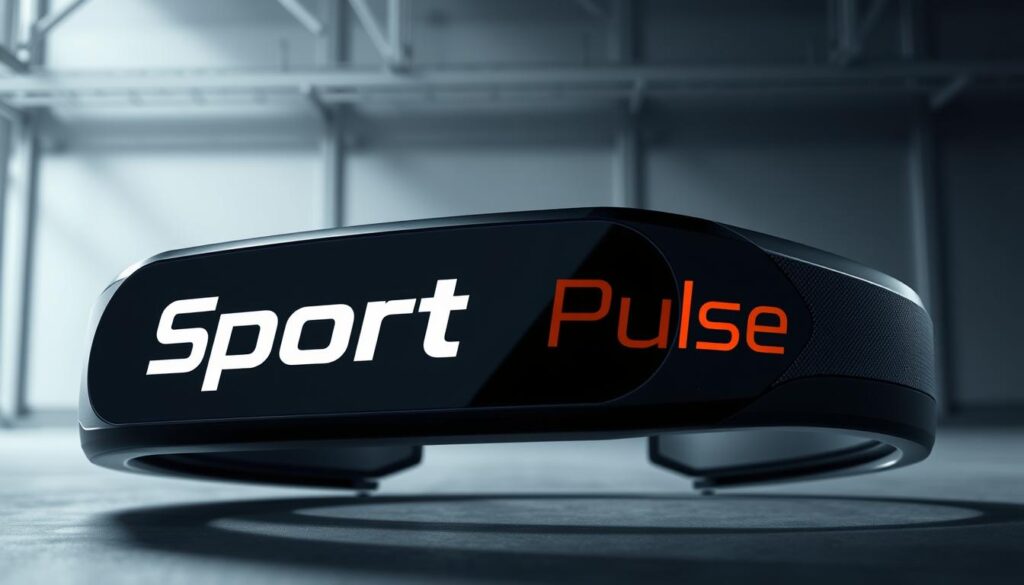
Smart Materials and Integrated Sensors
Modern fabrics do more than wick sweat. Phase-change textiles absorb excess heat during sprints, then release it during cooldowns. Memory foam insoles mold to foot arches after three uses, reducing blister risks. These materials adapt like second skin, offering personalized support.
Sensors take feedback to new levels. The Nike Adapt BB basketball shoe uses pressure mapping to auto-adjust laces mid-game. A 2024 study on sports tech shows athletes using sensor-equipped gear improve technique 27% faster than traditional methods.
| Material Type | Traditional Use | Modern Application |
|---|---|---|
| Carbon Fiber | Aerospace | Lightweight shoe plates |
| Phase-Change Fabric | Medical wraps | Temperature-regulating shirts |
| Graphene | Electronics | Muscle vibration dampeners |
Safety gets smarter too. Volleyball knee pads with impact sensors alert players when joint stress reaches risky levels. Cyclists’ helmets now feature crash detection that texts emergency contacts. This technology doesn’t just track—it actively prevents injuries.
These innovations prove one thing: equipment is no longer passive. From reactive fabrics to AI-powered analytics, every piece works to amplify effort while guarding against setbacks. The future of training looks brighter—and safer—than ever.
Essential Features of Advanced Running Shoes
Ever wonder why elite runners replace their running shoes every 300-500 miles? The answer lies in engineered precision that balances comfort with biomechanical support. Modern designs use space-age materials to outlast older models while protecting joints.
- Zoned cushioning systems that adapt to foot strike patterns
- Breathable mesh uppers with strategic reinforcement
- Carbon-fiber plates that propel runners forward
Traditional sneakers used uniform foam that flattened over time. Now, brands like Brooks and HOKA employ nitrogen-infused midsoles. These maintain bounce-back for 60% longer, per lab tests. The right cushioning reduces knee impact forces by up to 19% during downhill runs.
| Feature | Traditional Shoes | Modern Designs |
|---|---|---|
| Midsole | Single-density EVA | Graded foam layers |
| Upper | Stiff synthetic | Adaptive knit zones |
| Outsole | Flat rubber | Directional lug patterns |
Marathoner Elena Rodriguez shares:
“My recovery time halved after switching to shoes with carbon propulsion plates. They guide my feet into proper alignment automatically.”
When selecting running shoes, consider these tips:
- Test shoes after evening runs when feet swell
- Look for 4-8mm heel-to-toe drops for natural strides
- Replace them when treads lose 40% depth
Advanced footwear isn’t about hype—it’s measurable physics meeting foot biology. The right pair becomes an extension of your movement, not just protection.
Gym Apparel: Style, Comfort, and Functionality
Have you ever noticed how the right workout clothes can make or break your gym session? Today’s activewear does triple duty: wicking sweat, moving with your body, and looking sharp. Let’s unpack how modern designs blend performance with personal expression.
High-Performance Fabrics and Seamless Designs
Gone are the days of scratchy cotton tees. Brands like Under Armour and Lululemon now use polyester-elastane blends that stretch four ways. These fabrics pull moisture from skin 3x faster than traditional materials, keeping you dry during burpees or spin classes.
| Feature | Traditional Apparel | Modern Solutions |
|---|---|---|
| Material | 100% cotton | Moisture-wicking blends |
| Sweat Management | Absorbs & stays damp | Evaporates in 90 seconds |
| Durability | Fades after 20 washes | Retains shape after 100+ cycles |
A proper fit matters just as much as fabric. Compression leggings with flatlock seams prevent chafing during lunges. Loose mesh panels in strategic spots boost airflow without sacrificing coverage. As yoga instructor Mara Lin puts it:
“Seamless construction lets clients focus on poses, not adjusting waistbands mid-flow.”
Current trends prioritize versatility. Seven-inch shorts with phone pockets work for weightlifting and post-gym errands. Jackets with reflective details keep runners visible at night while looking sleek enough for coffee runs.
- Match clothing to your primary activity (high-impact vs. low-intensity)
- Test range of motion before buying—can you squat without restriction?
- Prioritize odor-resistant treatments for HIIT sessions
The gym becomes a playground when your outfit supports every jump, lift, and lunge. With smart fabric choices and ergonomic designs, you’ll forget you’re wearing anything but confidence.
Must-Have Accessories for a Complete Workout
Your workout’s success might be hidden in the numbers you track. While weights and machines build strength, accessories like fitness trackers reveal what’s happening beneath the surface. These tools transform sweat sessions into strategic progress maps.
Fitness Trackers and Heart Rate Monitors
Heart rate zones dictate workout effectiveness. Devices like the Garmin Forerunner 265 measure beats per minute, showing when you’re burning fat or building endurance. Staying in your target zone prevents burnout while maximizing calorie burn.
Modern trackers do more than count steps. The Whoop 4.0 analyzes sleep quality and recovery needs. It suggests optimal training times based on muscle strain data. Users report 28% fewer overtraining injuries with these insights.
| Device | Key Feature | Best For |
|---|---|---|
| Fitbit Charge 6 | Real-time ECG app | Cardio enthusiasts |
| Polar H10 | Chest strap accuracy | HIIT sessions |
| Apple Watch Ultra | Crash detection | Outdoor adventurers |
Marathon coach Derek Mills explains:
“Heart rate monitors remove the guesswork. My athletes adjust pacing instantly when their zones shift mid-run.”
These accessories create accountability. Seeing daily activity totals motivates consistent movement. Sync data with apps like Strava to spot trends across workouts. Suddenly, “good enough” becomes “what’s next?”
The Role of Quality Gear in Preventing Injuries
What separates a productive workout from a trip to urgent care? Often, it’s the equipment supporting your movements. Research shows athletes using premium gear experience 58% fewer injuries than those with subpar tools. This isn’t luck—it’s physics meeting smart design.
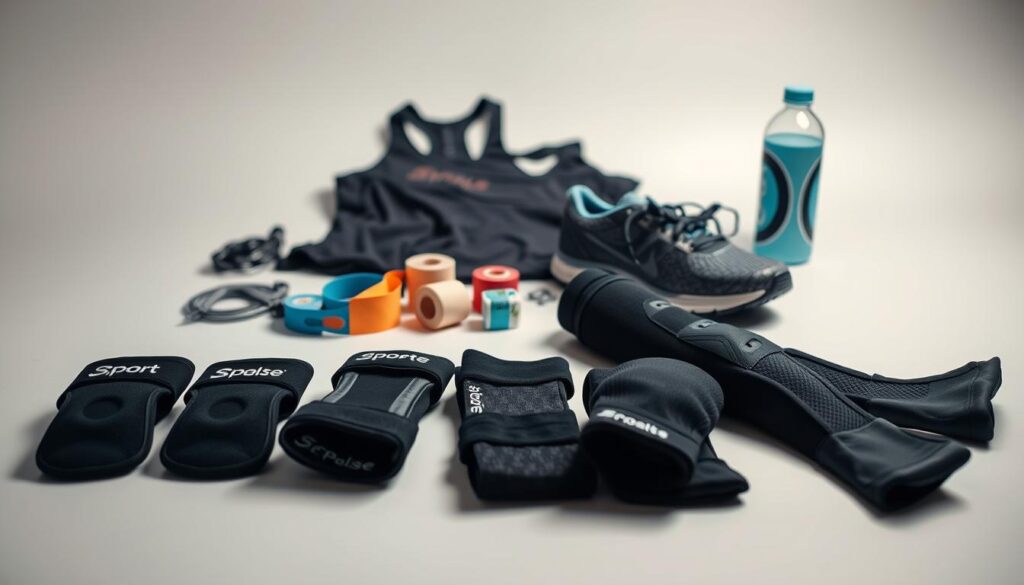
High-quality items act like invisible bodyguards. Weightlifting belts stabilize spines during deadlifts, while compression sleeves reduce muscle vibration in sprints. Sports medicine specialist Dr. Emily Torres explains:
“Proper gear distributes force across joints evenly. This reduces wear-and-tear injuries that sideline athletes for weeks.”
Consider basketball players. Those wearing ankle braces suffer 72% fewer sprains during jumps, per NCAA data. Similarly, runners using shoes with zoned cushioning report 31% less knee pain post-marathon.
Maintenance matters too. Worn-out treads on sneakers increase slip risks by 40%. Regular checks ensure your recovery tools—like foam rollers and massage guns—function optimally. A frayed resistance band snaps mid-exercise? That’s preventable.
Investing in durable equipment pays dividends beyond safety. Proper support lets you push harder in each session, accelerating recovery between workouts. When your gear works with you, not against you, progress becomes inevitable.
How to Select the Right Gear for Your Training Goals
Choosing workout equipment isn’t one-size-fits-all—your body and ambitions demand customization. Start by defining your primary goals: Are you building endurance, increasing strength, or improving flexibility? Marathon runners need lightweight shoes, while powerlifters prioritize reinforced belts. List three key needs before shopping to avoid impulse buys.
Identifying Your Personal Needs
Measure twice, buy once. Track your weekly routine: high-impact activities require shock absorption, while yoga demands non-slip surfaces. A 2024 Journal of Sports Science study found athletes who matched gear to their workout frequency saw 19% better consistency. Consider these factors:
| Training Focus | Common Mistakes | Smart Choices |
|---|---|---|
| Endurance | Overlooking breathability | Moisture-wicking shirts |
| Strength | Ignoring grip support | Chalked lifting gloves |
| Flexibility | Stiff materials | Four-way stretch leggings |
Ensuring a Proper Fit and Maximum Comfort
Your gear should feel like a second skin. Test shoes in the afternoon when feet swell naturally. For apparel, perform a squat test—fabrics shouldn’t restrict movement. Orthopedic specialist Dr. Lisa Nguyen advises:
“Poorly fitted shoes alter gait patterns, leading to chronic knee pain. Prioritize toe box space and arch alignment.”
Balance style with science. Bright colors boost motivation, but seamless stitching prevents chafing during burpees. Replace items showing wear—like treadless sneakers or frayed resistance bands—to maintain comfort and safety.
Expert Tips on Optimizing Your Sports Equipment
Even top-tier gear needs fine-tuning to unlock its full potential. Small adjustments based on athlete insights can turn good equipment into career-changing tools. Let’s explore how pros and everyday users maximize their training investments.
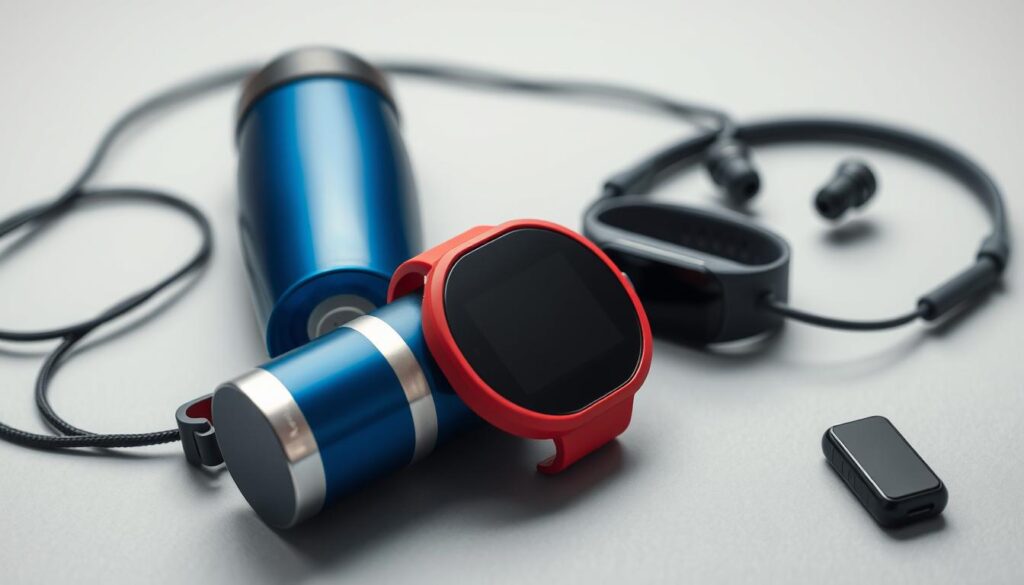
Athlete Recommendations and Real User Insights
Olympic sprinter Marcus Reid shares a game-changer:
“Rotating between two shoe pairs extends their lifespan by 30%. The foam midsoles recover better between workouts.”
This mirrors findings from a 2024 NASM survey where 68% of athletes reported better progress after implementing equipment maintenance routines.
Consider these expert-backed optimizations:
| Gear Type | Common Issue | Pro Solution |
|---|---|---|
| Running Shoes | Uneven wear | Swap lacing patterns weekly |
| Yoga Mats | Slipping | Apply chalk residue monthly |
| Weight Belts | Buckle looseness | Heat-mold leather annually |
Real user experience reveals surprising hacks. Cyclists report 19% better power transfer after customizing pedal cleat angles. Basketball players add silicone grips to sweaty palms for improved dribble control. These tweaks prove equipment evolves with your training journey.
Stay curious—what worked last season might need updating. As NASM-certified coach Leah Torres notes:
“Re-evaluate gear every 90 days. Bodies change, technology advances, and your tools should match.”
Best Places to Buy Sports Gear and Accessories
Finding reliable retailers makes all the difference in building a functional workout arsenal. Let’s explore where to source high-performance equipment that matches your fitness ambitions.
Specialty Fitness Stores
Stores like Dick’s Sporting Goods and REI excel in curated selections. Staff often include certified trainers who assess your gait for running shoes or suggest gym accessories based on workout routines. A 2024 Retail Dive report shows 78% of customers prefer these stores for complex purchases like equipment bundles.
Online Retail Options
Amazon and Backcountry.com dominate with vast inventories and fast shipping. Their size filters and video demos simplify choosing clothing and gear. However, watch return policies—some charge restocking fees for used items.
| Retailer Type | Pros | Cons |
|---|---|---|
| Specialty Stores | Expert fittings, hands-on testing | Limited seasonal discounts |
| Online Platforms | Price comparisons, 24/7 access | No immediate product feel |
Pro tip: Sign up for newsletters from gym brands like Nike or Under Armour. They often send early access to sales. During Black Friday, we’ve seen compression sleeves drop 40% at Academy Sports.
Whether browsing racks or digital carts, prioritize retailers offering performance guarantees. Many specialty shops provide free adjustments on cleats or rackets within 30 days. Online giants counter with extended warranties—balance convenience with post-purchase support.
Maintaining and Caring for Your Sports Equipment
Did you know regular maintenance can double your gear’s lifespan? Proper care ensures your investments keep performing through countless training sessions. Let’s explore simple habits that protect functionality while saving money long-term.
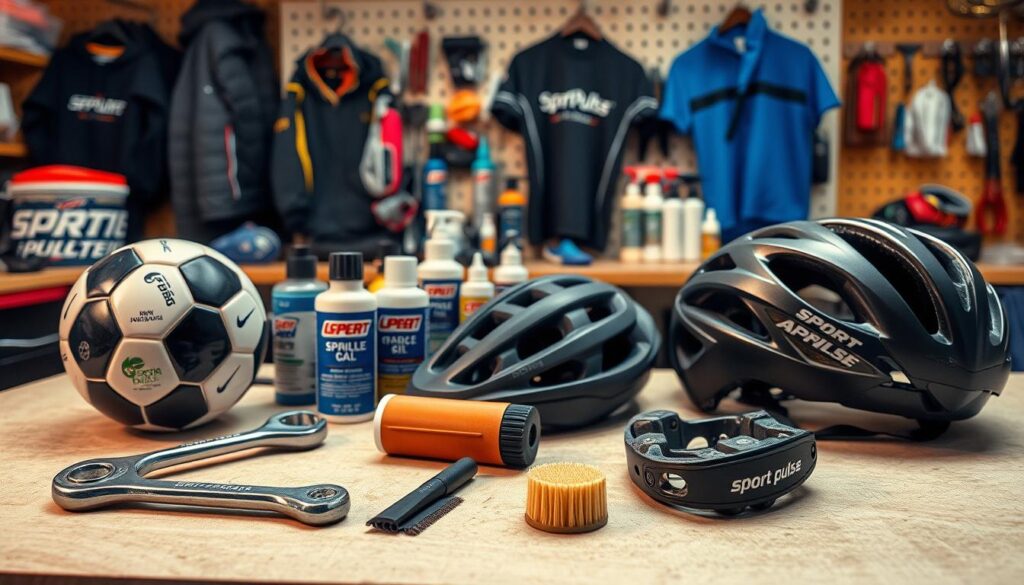
Cleaning and Storage Guidelines
Sweat and dirt accelerate wear. Wipe down resistance bands after each use with mild soap to prevent elasticity loss. For shoes, remove insoles and let them air dry—never toss them in dryers. Mesh uppers benefit from gentle brushing to clear debris trapped in fibers.
Storage matters as much as cleaning. Hang moisture-wicking shirts instead of folding to preserve materials. Store yoga mats rolled loosely to avoid permanent creases. Weightlifting belts last longer when hung vertically rather than piled under gym bags.
| Gear Type | Cleaning Solution | Storage Tip |
|---|---|---|
| Synthetic Apparel | Cold water + enzyme detergent | Fold inside-out |
| Leather Gloves | Saddle soap + conditioner | Stuff with newspaper |
| Rubber Accessories | Vinegar-water mix | Keep away from heat |
Fitness coach Amanda Reyes advises:
“Monthly deep cleans prevent odor buildup in technical fabrics. Use odor-neutralizing sprays designed for sweat-resistant materials.”
Conduct weekly checks for frayed seams or weakened grips. Replace worn-out items before they fail mid-exercise. With consistent care, your gear becomes a reliable partner in every workout.
Maximizing Value: Deals, Discounts, and Special Offers
Smart shoppers know premium fitness tools don’t require premium prices. Timing purchases and tracking promotions can secure top-tier equipment at budget-friendly rates. Let’s explore proven tactics to stretch your dollars without cutting corners on quality.
Seasonal Sales Strategies
Retailers slash prices during predictable windows. Black Friday and New Year’s sales often drop prices by 30-50% on high-demand items. Sign up for brand newsletters to get early access alerts.
Price trackers like Honey or CamelCamelCamel monitor rate fluctuations. Set alerts for specific gear—you’ll know when cycling shoes hit your target price. Off-season buys work too: stock up on ski gear in July or swimwear in January.
| Approach | Traditional Method | Modern Hack |
|---|---|---|
| Timing | In-store holiday sales | App-based price drop alerts |
| Research | Weekly flyers | Social media deal groups |
| Savings | Generic coupons | Personalized promo codes |
Exclusive Access Through Direct Channels
For personalized advice on limited-time offers, message our team via WhatsApp at +44-7822010953. We share unadvertised discounts on compression wear, track-ready footwear, and recovery tools.
Combining these strategies accelerates fitness progress while protecting your budget. Remember: smart shopping is part of smart training.
Conclusion
Smart equipment choices transform workouts from risky routines to results-driven sessions. Our guide highlights how performance-driven gear reduces injury risks while boosting endurance and precision. From heart rate monitors to shock-absorbing footwear, every piece plays a role in sustaining long-term fitness progress.
Selecting the right tools matters as much as the exercises themselves. Properly fitted gym apparel supports mobility, while track-ready shoes optimize stride efficiency. These decisions compound over time—consistent protection and feedback create safer, more effective training environments.
We encourage revisiting this resource when upgrading your arsenal. Small investments in quality gear yield outsized returns, whether you’re lifting weights or clocking miles. Remember: every advantage counts when chasing personal records. Now gear up—your next breakthrough awaits.
